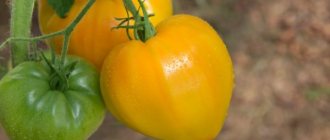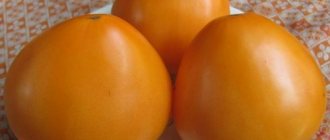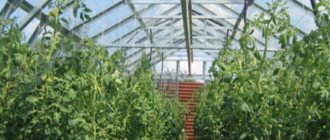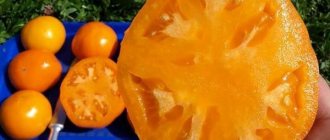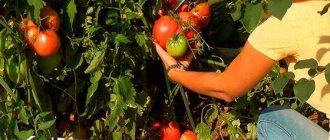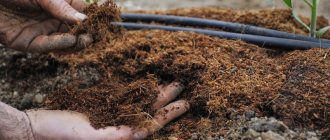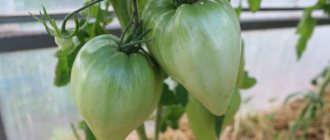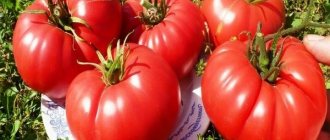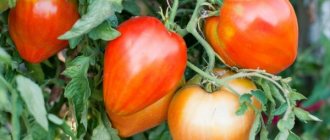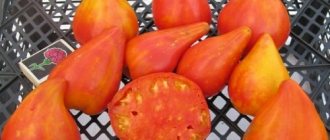Description of the variety
Orange Heart tomatoes were bred by Russian breeders. The variety was intended for fresh consumption. But consumers have expanded the recommendations of the originators: juices, pastes, and mixed canned vegetables are prepared from tomatoes.
Features of the variety:
- created for cultivation in open ground (southern regions) and unheated greenhouses;
- average ripening period (95–100 days pass from germination to the first berries);
- tall (stretches up to 1.8 m on the street, up to 2 m in a greenhouse);
- the plant is powerful, the stems are thick and woody;
- medium sized leaf plate;
- the color of the tops is bright green;
- tests showed average resistance to major tomato diseases;
- The plant is unpretentious to the composition of the soil: it produces crops everywhere.
Farmers note: the maximum you can get is 6.2 kg per bush. This is the yield for growing in a greenhouse. In open ground the indicator decreases.
Hardening
To strengthen the immune system, plants undergo periodic hardening before planting. The technique is simple: every day the ventilation time in the open air is increased. When the plant calmly tolerates hardening for up to several hours, you can plan planting.
To increase productivity, use a simple grandmother's method. Soon after planting, a yellow formation appears on the stems - flowers and an ovary, from which the fruit is formed. Since tomatoes are representatives of self-pollinating plants, it is recommended to shake the bushes periodically. This helps the formation of the ovary, which leads to increased yield.
What fruits grow?
Farmers are interested in the possibility of quickly selling their grown tomatoes. In terms of taste, Orange Heart is the leader among yellow salad tomatoes. Description of berries:
- the shape is round, slightly elongated, with a characteristic “nose” at the bottom;
- in a greenhouse, tomatoes gain weight over 350 g, in open ground - about 200 g;
- The color of the ripe fruit is bright yellow, sometimes slightly orange;
- an unripe fruit has a green spot in the area of the stalk;
- the pulp is low-juicy, dense;
- number of seed chambers - 3–4;
- few seeds;
- the skin is thin and easily damaged;
- The taste is sweet, the acid is not felt.
See also
Description of the tomato variety Raspberry giant, features of cultivation and care
Read
Tomatoes do not store well. The thin skin makes transportation difficult. To preserve marketability, farmers growing Orange Heart should shorten the path of the crop from the field to the counter.
Tomato Orange Heart: reviews, photos
Increasingly, gardeners prefer yellow or orange tomato varieties, and this is absolutely justified by their beneficial properties. Thus, several years ago, American scientists proved that tetra-cis-lycopene contained in orange tomatoes slows down the aging process of the human body. Such vegetables also contain a large amount of carotene, minerals and vitamins, which often exceeds the content of similar microelements in red fruits. Orange tomatoes do not cause allergies and can be consumed not only by adults, but also by children. The distinctive characteristics of yellow tomatoes have become the reason for their wide distribution. At the same time, the range of orange varieties is large, and choosing one good variety can be quite difficult.
Today we invite our readers to get acquainted with the “Orange Heart” tomato, a description of the variety and its characteristics.
Detailed description of the orange variety
Orange Heart tomatoes were bred by Russian breeders relatively recently. They quickly gained recognition among farmers due to their unpretentiousness and excellent fruit characteristics. Resistance to various climatic conditions has made it possible to grow orange tomatoes in all regions, from the south to the north of the country.
Plant information
Orange Heart tomatoes are indeterminate and heavily leafy. Tall bushes of this variety grow up to 2 meters or more, requiring careful shaping and reliable garter.
It is recommended to form “Orange Heart” tomato bushes into two stems. The experience of farmers shows that this is the method that allows you to obtain maximum crop yield. The process of such formation is described in detail in the video:
The leaves of "Orange Heart" tomatoes are powerful, dark green. They are formed in large quantities on the trunk of the plant. The lower ones must be removed every 10-15 days (3-4 leaves at a time). This will help to properly distribute nutrients in the plant’s body, increase the yield of tomatoes and reduce the likelihood of developing diseases.
The root system of tomatoes is powerful. It requires a large area for its successful development and nutrition of tomatoes, so breeders recommend planting no more than two bushes per 1 m2 of land.
Tomato inflorescences appear every 2-3 leaves. The first of them is formed in the 7-8 sinuses. Each flowering raceme contains 3-6 simple flowers. The ovaries are usually formed successfully, ensuring consistently high yields of tomatoes.
Characteristics of tomatoes
It’s not for nothing that “Orange Heart” tomatoes got their name: their shape is heart-shaped and their color is orange. The correspondence of this description to external characteristics can be assessed by viewing the following photo:
The heart-shaped shape of the tomatoes is complemented by a number of ribs at the stalk and a pointed tip. The skin of these tomatoes is thin and tender. The inner pulp contains a large amount of dry matter and very few seeds. The aroma of vegetables is bright and rich. The taste of tomatoes is dominated by sweetness and there is a subtle sourness.
Orange tomatoes are heart-shaped and large. Their average weight is 150-200 g. The very first fruits ripen weighing up to 300 g. Tomatoes grown in particularly favorable conditions can reach the same record levels.
Tomatoes with excellent taste characteristics can be used in the preparation of fresh snacks, pasta and winter preparations. Vegetables are also suitable for baby food. The juice from Orange Heart tomatoes is very sweet.
It is worth noting that Orange Heart tomatoes can also be grown commercially. Slightly unripe tomatoes have good keeping quality and transportability. The presentation of such fruits is preserved for a long time.
Crop yield
The ripening period for tomatoes of the “Orange Heart” variety is 110-120 days. This is exactly how much time is needed so that from the day the shoots emerge you can enjoy ripe tomatoes. The fruiting process of the variety is long and, in favorable conditions, can continue until the onset of frost. In open ground, it will be possible to harvest ripe tomatoes of this variety within 40-60 days.
Over the entire fruiting period, each “Orange Heart” tomato bush gives the farmer from 6 to 10 kg of tomatoes. At the same time, the yield indicator can change both up and down depending on external factors, soil fertility, and compliance with growing rules. In general, it is worth noting that the “Orange Heart” variety is very grateful and always responds positively to the care shown by the farmer.
Disease resistance
One of the advantages of the Orange Heart variety is the high degree of protection of tomatoes from common diseases. And many farmers are confident that genetic immunity is able to withstand even the most powerful attacks of viruses, fungi and bacteria. In fact, this is not entirely true, because the immune defense cannot independently cope with aggressive ailments in conditions favorable to microorganisms. That is why you need to remember the following rules:
- Loosening, timely weeding, and mulching the soil are the main preventive methods of disease control.
- Tomatoes should be watered regularly, without allowing moisture to stagnate.
- When planting tomatoes, you need to take into account the recommendations of crop rotation.
- The optimal conditions for the growth and fruiting of tomatoes are a temperature of +23-+26 0 C and a humidity of about 50-70 0 C. To maintain such a microclimate, you need to regularly ventilate the greenhouse.
- To prevent diseases, you can use special biological products or folk remedies. For example, in the fight against common late blight, you can use fungicides, copper-containing preparations or iodine solution.
- To combat pests, you can use herbal infusions (celandine, wormwood), ammonia solution or soap solution.
When growing Orange Heart tomatoes, it is worth remembering that only a set of preventive measures in combination with the natural immunity of this variety will help protect plants from the most common and dangerous diseases. At the same time, regular and thorough inspection of the bushes, if necessary, will help to quickly detect the problem and eliminate it.
Advantages and disadvantages
Tomatoes of the proposed orange variety have a lot of significant advantages, which include:
- Excellent taste and aroma of tomatoes, their meatiness.
- Original appearance of tomatoes.
- High content of vitamins, acids, minerals and fiber in the product.
- Good yield of vegetables.
- Transportability of tomatoes and their suitability for long-term storage.
- Genetic resistance to diseases.
- The variety is highly sensitive to fertilizing, which allows you to further increase crop yield.
The only drawback, or rather a feature of the variety, is the need to form indeterminate bushes, regularly removing stepsons and powerful lower leaves from them. It is worth noting that this feature in care is typical for all indeterminate varieties.
Tips for farmers
Growing orange tomatoes is not at all difficult if you know exactly how to do it correctly. And the cultivation technology for the proposed variety is as follows:
- At the end of February or mid-March (for greenhouses and open ground, respectively), sow tomato seeds for seedlings, having previously treated them with disinfectants and growth stimulants.
- Seeds can be sown in a common container or individual pots. It is necessary to deepen the grains by 1-1.5 cm.
- It is recommended to water the seedlings with a spray bottle so as not to wash out the embedded seeds.
- With the appearance of 2 true leaves, young plants, if necessary, are planted in separate containers.
- 1-2 weeks after picking, the seedlings need to be fed with organic matter or complex fertilizer with a high nitrogen content.
- At the age of 60-65 days, tomato seedlings can be planted in the ground, but before that you need to feed the plants with potassium and phosphorus for the development of the root system.
- To plant tomatoes in a garden bed you need 2-3 bushes for every 1 m2 of soil.
- 2 weeks after planting, the tomatoes need to be fed again.
- At the active growth stage, form plants into 2 stems.
The growing rules given are quite simple. They also work when cultivating not only this variety, but also all other indeterminate tomatoes with an average period of fruit ripening. It is worth remembering that orange tomatoes actively respond to fertilizing, and excessive amounts of fertilizer can harm the plants. In order not to cause harm to tomatoes, you need to monitor their condition and signals about a deficiency (excess) of a particular substance.
Conclusion
Orange Heart tomatoes deserve the attention of beginners and experienced farmers. They are very tasty, healthy and have an interesting, bright appearance. They have a lot of advantages and are practically devoid of disadvantages. They can be successfully grown in greenhouses and open beds, and the harvest in any case will be abundant. Large tomatoes can be successfully served on the table for adults and children, canned for the winter or stored. At the same time, one thing is certain: delicious vegetables will not be lost, because they have many admirers.
Growing
The variety is undemanding to soil. It produces crops on any soil. But the daytime temperature should be within 25 degrees Celsius. Farmers should follow the advice of agronomists:
- Seed stratification for 2–3 weeks will help increase resistance to climatic conditions. Dry planting material is placed in the fruit compartment of the refrigerator.
- Own seeds require testing for germination and disinfection. Germination is checked by placing dry material in a glass of water. Empty ones float up. For disinfection, use a dark pink solution of potassium permanganate.
- Seedlings should be driven out 2–3 months before the intended planting in a permanent place.
- Plants require picking when 2 true leaves appear. Stretched tomatoes should be buried down to the cotyledon leaves.
- Orange heart requires fertilizing with organic matter and mineral fertilizers. It is necessary to stop applying the complexes 2 weeks before the start of harvest.
- The bushes should be placed according to the following scheme: 50x60 cm. In this case, it is necessary to plant no more than 3 plants per square meter.
- The tomato needs formation: it is optimal to grow it in 2-3 stems.
- The plant requires staking and moderate pinching. These measures will allow you to get fruits of equal size.
The orange heart bears fruit for 1.5–2 months. It is recommended to regularly pick ripe fruits: green ones will ripen faster.
Tomato Orange Heart
photo by Valentina Redko
Description and characteristics of the tomato variety Orange Heart, reviews, photos
Many people fell in love with the popular name of this variety - Liskin Nos .
Mid-season, indeterminate (unlimited growth), tall tomato variety for greenhouses.
The bush is powerful, densely leafy (which is rare for heart-shaped tomatoes), up to 1.8 meters high. It requires tying the plant to a support and pinching. The best results were obtained when forming a bush with 2 stems. How to form an Orange Heart tomato, see the video below.
The leaves of this tomato are large and dark green. The inflorescence is simple.
Basic qualities of fruits
photo by Valentina Redko
The fruits are heart-shaped, dense, yellow-orange in color at maturity, weighing 120-300 grams, juicy and sweet. These tomatoes are good for fresh consumption, making juices and sauces.
The variety is resistant to Alternaria leaf spot, cladosporiosis and tobacco mosaic virus.
This variety is included in the State Register of Breeding Achievements in the Russian Federation for cultivation in open ground and under film covers on private farms.
Features of growing tomatoes Orange heart, planting and care
We recommend sowing the seeds of this tomato for seedlings 60-65 days before the intended planting in the greenhouse. Dive - at the stage of 2 true leaves. When transplanting seedlings to a permanent place, 1 sq. It is recommended to place up to 3 plants per meter of land. Planting pattern : 60 x 50 cm.
Further care for tomatoes consists of pinching, timely watering, fertilizing with complex mineral fertilizers, weed removal and preventive measures to protect plants from pests and diseases.
When growing tomatoes in a greenhouse, we recommend installing a drip irrigation system - this will save your time and effort, as well as increase plant productivity and reduce the risk of late blight.
Formation of tall tomatoes on video
If you grew Orange Heart tomatoes, please write whether you liked them or not. What was the yield and taste of the fruit in your climatic conditions? How do you rate the disease resistance of this variety? Briefly describe the advantages and disadvantages of this tomato in your opinion, and evaluate its taste. If possible, attach to the comment a photo of the entire bush as a whole or individual fruits that you grew. Thank you!
Your reviews of the Orange Heart tomato and additions to the description will help many gardeners evaluate this variety more objectively and decide whether it is worth planting or not.
Features of care
Farmers in the southern regions grow the variety for personal consumption. For cultivation on an industrial scale, it is necessary to organize the rapid sale of the crop. Farmers in problem areas are trying to plant tomatoes in unheated greenhouses.
Tomato is sensitive to soil and air moisture. In closed ground, problems are solved by drip irrigation and ventilation of the greenhouse.
The variety does not tolerate even short droughts: when watering is resumed, the thin skin cracks and the tomatoes lose marketability.
See also
Description of the tomato variety Amber Honey, its pros and cons
Read
The yellow tomato sheds its ovaries when the temperature fluctuates. With a sharp increase, pollen is sterilized. Covering the greenhouse with light non-woven material (or whitewash) will help protect plantings in closed ground.
Planting
It is best to plant seedlings in the evening. Delicate foliage is sensitive to sunlight and may be damaged. After planting, it is necessary to water the plant at the root. After the adaptation period, you can organize a regular feeding and watering schedule.
Temperature
The most favorable temperature for normal crop growth is in the range of +18 – 25 degrees:
- When lowered, all metabolic processes slow down, which can lead to the death of stems, leaves and damage developing hearts.
- The increase also does not provide the expected acceleration in growth. At temperatures above 25 degrees, tomatoes may become sterilized and not bear fruit.
The characteristics and description of the tomato variety Orange Heart do not say about the influence of other crops on plant growth. If you take this point into account, you can achieve increased productivity.
All you need to do is follow a few simple tips:
- Tomatoes belong to the nightshade family and tolerate well proximity, for example, to peppers. You can plan in advance to plant different crops in one garden or greenhouse.
- Crop rotation. By applying agricultural production methods in practice, significant results can be achieved. The rules of farming work well on a private plot. When planting crops of the same family on the same soil, we contribute to its degeneration.
This is due to two factors:
- consumption of similar elements;
- development of a population of aggressive bacteria.
By following simple tips and relying on your own experience, you can get an excellent harvest of Orange Heart tomatoes.
Unpretentiousness and good yield, an unforgettable sweetish taste and excellent culinary compatibility with other products make this variety popular with many agricultural enthusiasts.
The Orangeheart tomato is rarely found in farmers' fields. It's a pity! This is one of the best salad tomato varieties. Gardeners have been growing Orange Heart in their plots for a long time. Sometimes the variety is found in private household plots. But owners of large planting areas bypass it: they are interested in the high profitability of cultivating the crop.
There are a variety of tomatoes sold at farmers' markets. But this one doesn’t come across the shelves very often. And buyers praise the taste of tomatoes and admire their appearance. In recent years, farmers in the southern regions have turned their attention to the Orange Heart. The path from field to field to the counter is short, yield losses are small. And residents of the northern regions who do not have a garden can only read about the merits of the variety.
Advantages and disadvantages
Farmers are studying the characteristics of the Liskin Nos tomato. The advantages are:
- original shape (resembles the face of a fox);
- sweet taste;
- large size;
- fleshy pulp;
- undemanding to soil composition;
- buyer interest.
But the disadvantages for cultivation on a large scale are significant:
- not compact bush;
- susceptibility to diseases and pests;
- low transportability;
- demands on climatic conditions;
- short shelf life;
- insufficient yield;
- impossibility of storage without refrigeration units.
Before planting, farmers are advised to assess the characteristics of crop cultivation and possible risks.
Pests and diseases
Pests love the orange-like tomato. To identify enemies, it is recommended to place adhesive tape (fly trap) among the bushes. Daily inspection of adherent insects will allow you to select the right insecticide and reduce crop losses. Traps should be refreshed once a week.
To protect against fungal diseases, treatment with copper-containing preparations is suitable. Spraying should be stopped 3 weeks before harvesting.
It is important to remember: strict adherence to growing rules will reduce the risk of disease in the variety.
Harvest and storage
Liskin's nose has extended fruiting. It is recommended to pick the fruits slightly unripe: a green spot should remain in the area of the stalk. This measure will increase transportability.
Tomatoes should be stored in one row in a plastic or wooden container. Marketability is ensured by the presence of a modern refrigeration unit.
